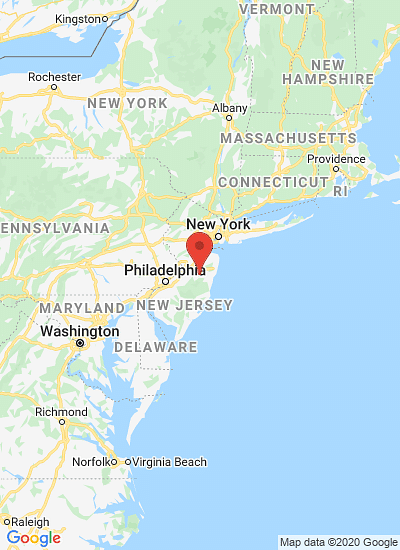Camden's Headquarters in New Jersey, United States
Campbell reported first-quarter fiscal 2023 Results
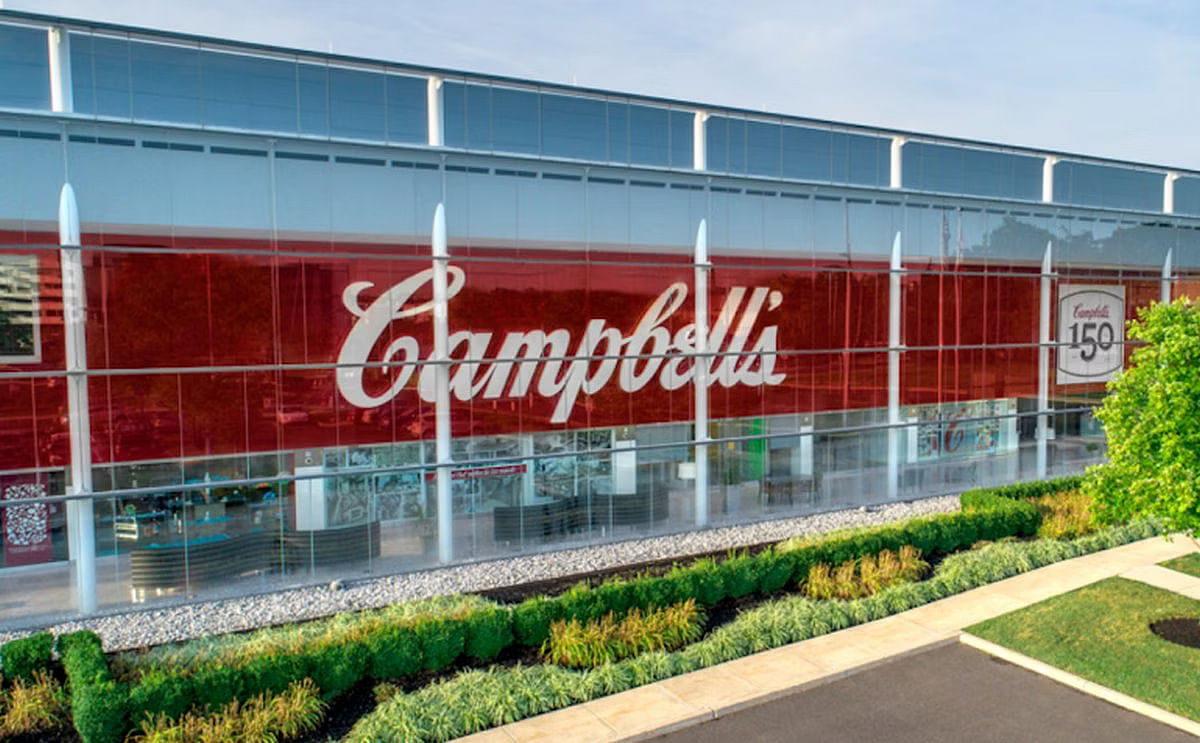
Campbell Soup Company (NYSE:CPB) reported results for its first-quarter fiscal 2023.
Mark Clouse, President and CEO of Campbell:
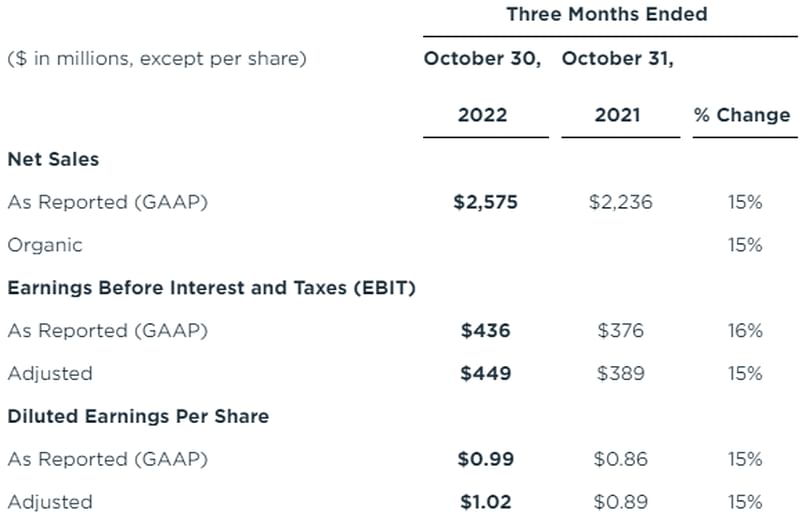 Items Impacting Comparability
Items Impacting Comparability
The table below presents a summary of items impacting comparability in each period.
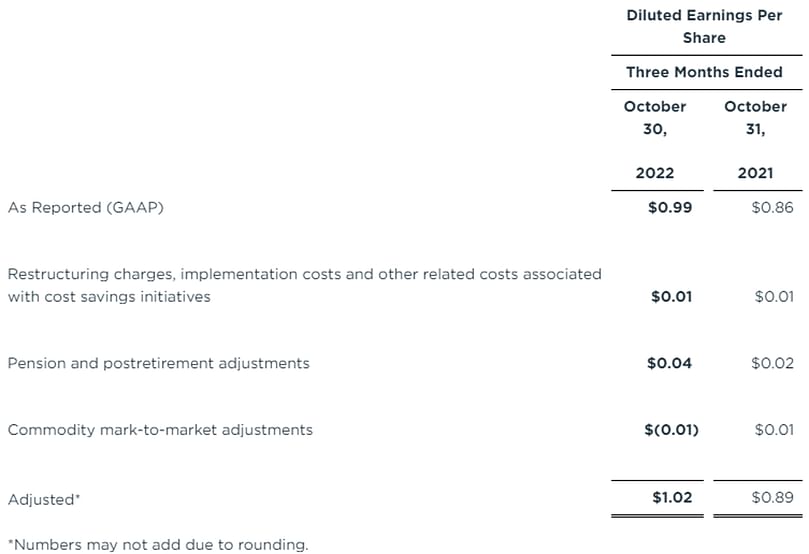 First-Quarter Results
First-Quarter Results
Net sales in the quarter, both as reported and organic, increased 15% versus the prior year to USD 2.6 billion. The combined impact of inflation-driven pricing and sales allowances more than offset volume declines.
Gross profit increased to USD 834 million from USD 722 million in the prior year. As a percent of sales, gross profit margin was 32.4% compared to 32.3% in the prior year. Excluding items impacting comparability, adjusted gross profit increased to USD 829 million from USD 727 million.
Excluding items impacting comparability, adjusted gross profit margin decreased 30 basis points to 32.2% as continued cost inflation and higher other supply chain costs as well as unfavorable volume / mix were mostly mitigated by inflation-driven pricing actions and productivity improvements.
Marketing and selling expenses increased 18% to USD 201 million and represented approximately 8% of net sales. The increase was driven by higher advertising and consumer promotion expense (A&C), which increased 31% versus moderated levels in the prior year, and higher selling expenses, partially offset by increased benefits from cost savings initiatives.
Administrative expenses, on both a reported and an adjusted basis, increased 1% to USD 158 million and USD 155 million, respectively.
Other expenses were USD 18 million compared to other income of USD 1 million in the prior year. Excluding items impacting comparability, adjusted other expenses were USD 3 million compared to other income of USD 7 million in the prior year primarily due to lower pension and postretirement benefit income.
As reported EBIT increased to USD 436 million from USD 376 million in the prior year. Excluding items impacting comparability, adjusted EBIT increased 15% compared to the prior year to USD 449 million primarily due to higher adjusted gross profit, partially offset by higher marketing and selling expenses and higher adjusted other expenses.
Net interest expense was USD 46 million compared to USD 47 million in the prior year. The tax rate was 23.8% compared to 20.7% in the prior year. Excluding items impacting comparability, the adjusted tax rate was 23.8% compared to 20.8% in the prior year primarily due to the favorable resolution of several tax matters in the prior year.
As reported EPS increased to USD 0.99 per share compared to USD 0.86 per share in the prior year. Excluding items impacting comparability, adjusted EPS increased USD 0.13, or 15%, compared to the prior year to USD 1.02 primarily reflecting the increase in adjusted EBIT, partially offset by a higher adjusted effective tax rate.
Cash flow from operations decreased from USD 288 million in the prior year to USD 227 million primarily due to changes in working capital, partially offset by higher cash earnings.
Capital expenditures were USD 77 million compared to USD 69 million in the prior year. In line with the company’s commitment to return value to its shareholders, the company paid USD 115 million of cash dividends and repurchased common stock of approximately USD 41 million.
At the end of the first quarter, the company had approximately USD 375 million remaining under the current USD 500 million strategic share repurchase program and approximately USD 131 million remaining under its USD 250 million anti-dilutive share repurchase program.
Cost Savings Program from Continuing Operations
In the first quarter, Campbell achieved USD 10 million of total savings under its multi-year cost savings program, inclusive of Snyder’s-Lance integration synergies, bringing total program-to-date cost savings to USD 860 million. Campbell remains on track to deliver savings of USD 1 billion by the end of fiscal 2025.
Full-Year Fiscal 2023 Guidance
Based on the company’s strong first quarter results which reflect continued demand for its products and improved supply chain execution, Campbell is raising its full-year fiscal 2023 net sales, adjusted EBIT and adjusted EPS guidance provided on September 1, 2022, while taking into account the volatile economic environment. The full-year fiscal 2023 guidance is set forth in the table below:
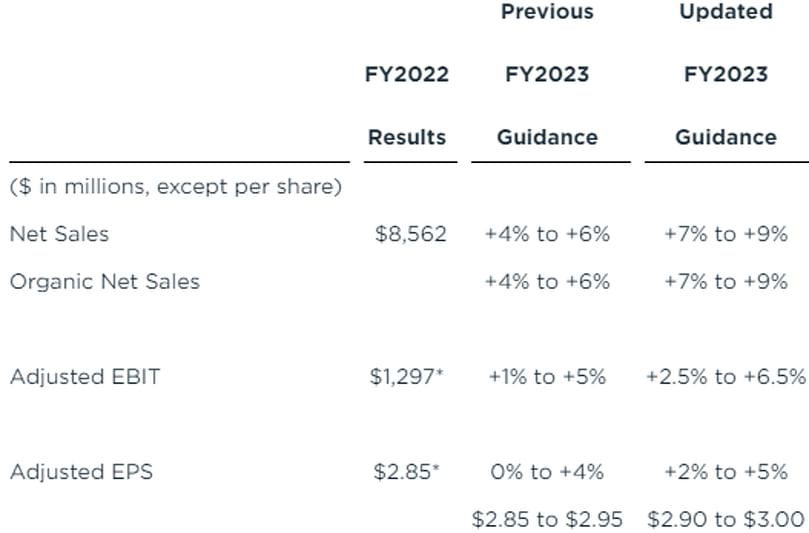 Segment Operating Review
Segment Operating Review
An analysis of net sales and operating earnings by reportable segment follows:
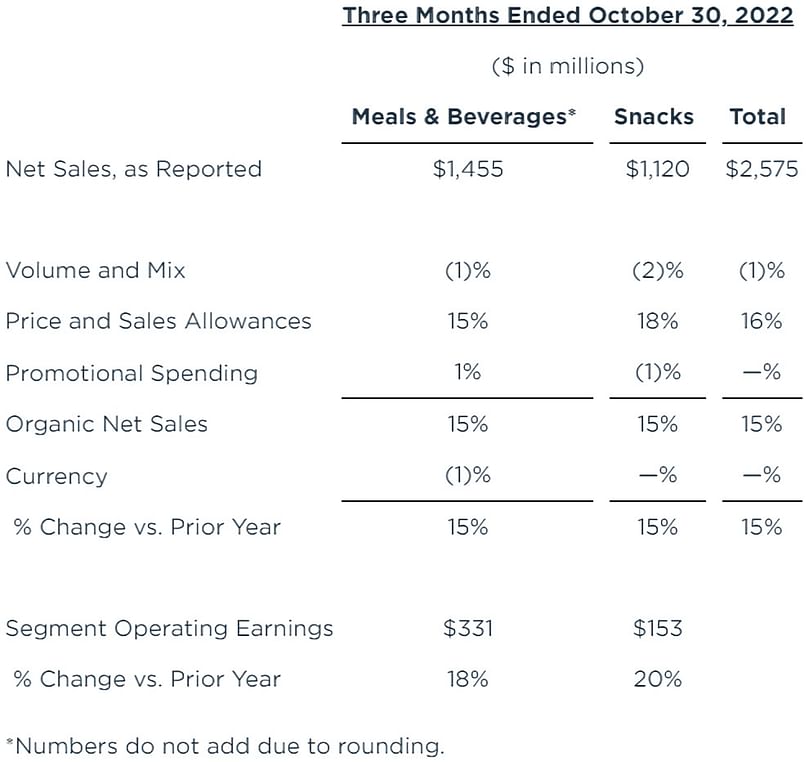 Meals & Beverages
Meals & Beverages
Net sales, both reported and organic, increased 15% in the quarter primarily due to increases in U.S. retail products, including U.S. soup and Prego pasta sauces, as well as gains in foodservice.
Inflation-driven pricing and sales allowances and lower levels of promotional spending were partially offset by volume declines. Sales of U.S. soup increased 11% due to sales increases in ready-to-serve soups, condensed soups and broth.
Operating earnings in the quarter increased 18% primarily due to higher gross profit, partially offset by higher marketing and selling expenses.
Gross profit margin increased driven by the impact of inflation-driven pricing actions, supply chain productivity improvements and lower levels of promotional spending, partially offset by higher cost inflation and other supply chain costs and unfavorable volume / mix.
Snacks
Net sales, both reported and organic, increased 15% driven by sales of power brands, which were up 21%. Sales growth was driven by increases in cookies and crackers, primarily Goldfish crackers, and in salty snacks, primarily Snyder’s of Hanover pretzels, and both Kettle Brand and CapeCod potato chips.
Inflation-driven pricing and sales allowances were partly offset by volume declines and increased promotional spending relative to moderated levels in the prior-year quarter. Operating earnings in the quarter increased 20% primarily due to higher gross profit and lower administrative expenses, partially offset by higher marketing and selling expenses.
Gross profit margin decreased driven by higher cost inflation and other supply chain costs, unfavorable volume / mix and higher levels of promotional spending, partially offset by the impact of inflation-driven pricing actions and supply chain productivity improvements.
Corporate
Corporate expense was USD 48 million in the first quarter of fiscal 2023 compared to USD 32 million in the prior year. Corporate expense in the current quarter included pension actuarial losses of USD 15 million, costs of USD 3 million related to cost savings initiatives and unrealized mark-to-market gains on outstanding undesignated commodity hedges of USD 5 million.
Corporate expense in the first quarter of fiscal 2022 included pension actuarial losses of USD 6 million, costs of USD 4 million related to cost savings initiatives and unrealized mark-to-market losses on outstanding undesignated commodity hedges of USD 3 million. After factoring in these items, the remaining increase in Corporate expense was primarily due to lower pension and postretirement benefit income.
Mark Clouse, President and CEO of Campbell:
"Our strong first-quarter results reflect our continued success in driving the relevance of our brands and improving our execution across our supply chain.."
"Through a combination of inflation-driven pricing actions and productivity improvements, we have substantially mitigated significant inflationary pressure in the quarter while continuing to provide quality and value to consumers."
"We are investing in the equity of our brands through effective marketing, delivering robust innovation and deploying efficient capital spending to ensure we continue to fuel improving in-market shares and growth."
"With the momentum of our strong first-quarter performance and confidence in our strengthened supply chain, we are raising our full-year fiscal 2023 guidance while taking into account the volatile economic environment."

Financial Information of Campbell Soup Company
The table below presents a summary of items impacting comparability in each period.

Items Impacting Comparability
Net sales in the quarter, both as reported and organic, increased 15% versus the prior year to USD 2.6 billion. The combined impact of inflation-driven pricing and sales allowances more than offset volume declines.
Gross profit increased to USD 834 million from USD 722 million in the prior year. As a percent of sales, gross profit margin was 32.4% compared to 32.3% in the prior year. Excluding items impacting comparability, adjusted gross profit increased to USD 829 million from USD 727 million.
Excluding items impacting comparability, adjusted gross profit margin decreased 30 basis points to 32.2% as continued cost inflation and higher other supply chain costs as well as unfavorable volume / mix were mostly mitigated by inflation-driven pricing actions and productivity improvements.
Marketing and selling expenses increased 18% to USD 201 million and represented approximately 8% of net sales. The increase was driven by higher advertising and consumer promotion expense (A&C), which increased 31% versus moderated levels in the prior year, and higher selling expenses, partially offset by increased benefits from cost savings initiatives.
Administrative expenses, on both a reported and an adjusted basis, increased 1% to USD 158 million and USD 155 million, respectively.
Other expenses were USD 18 million compared to other income of USD 1 million in the prior year. Excluding items impacting comparability, adjusted other expenses were USD 3 million compared to other income of USD 7 million in the prior year primarily due to lower pension and postretirement benefit income.
As reported EBIT increased to USD 436 million from USD 376 million in the prior year. Excluding items impacting comparability, adjusted EBIT increased 15% compared to the prior year to USD 449 million primarily due to higher adjusted gross profit, partially offset by higher marketing and selling expenses and higher adjusted other expenses.
Net interest expense was USD 46 million compared to USD 47 million in the prior year. The tax rate was 23.8% compared to 20.7% in the prior year. Excluding items impacting comparability, the adjusted tax rate was 23.8% compared to 20.8% in the prior year primarily due to the favorable resolution of several tax matters in the prior year.
As reported EPS increased to USD 0.99 per share compared to USD 0.86 per share in the prior year. Excluding items impacting comparability, adjusted EPS increased USD 0.13, or 15%, compared to the prior year to USD 1.02 primarily reflecting the increase in adjusted EBIT, partially offset by a higher adjusted effective tax rate.
Cash flow from operations decreased from USD 288 million in the prior year to USD 227 million primarily due to changes in working capital, partially offset by higher cash earnings.
Capital expenditures were USD 77 million compared to USD 69 million in the prior year. In line with the company’s commitment to return value to its shareholders, the company paid USD 115 million of cash dividends and repurchased common stock of approximately USD 41 million.
At the end of the first quarter, the company had approximately USD 375 million remaining under the current USD 500 million strategic share repurchase program and approximately USD 131 million remaining under its USD 250 million anti-dilutive share repurchase program.
Cost Savings Program from Continuing Operations
In the first quarter, Campbell achieved USD 10 million of total savings under its multi-year cost savings program, inclusive of Snyder’s-Lance integration synergies, bringing total program-to-date cost savings to USD 860 million. Campbell remains on track to deliver savings of USD 1 billion by the end of fiscal 2025.
Full-Year Fiscal 2023 Guidance
Based on the company’s strong first quarter results which reflect continued demand for its products and improved supply chain execution, Campbell is raising its full-year fiscal 2023 net sales, adjusted EBIT and adjusted EPS guidance provided on September 1, 2022, while taking into account the volatile economic environment. The full-year fiscal 2023 guidance is set forth in the table below:

Full-Year Fiscal 2023 Guidance
An analysis of net sales and operating earnings by reportable segment follows:

Segment Operating Review
Net sales, both reported and organic, increased 15% in the quarter primarily due to increases in U.S. retail products, including U.S. soup and Prego pasta sauces, as well as gains in foodservice.
Inflation-driven pricing and sales allowances and lower levels of promotional spending were partially offset by volume declines. Sales of U.S. soup increased 11% due to sales increases in ready-to-serve soups, condensed soups and broth.
Operating earnings in the quarter increased 18% primarily due to higher gross profit, partially offset by higher marketing and selling expenses.
Gross profit margin increased driven by the impact of inflation-driven pricing actions, supply chain productivity improvements and lower levels of promotional spending, partially offset by higher cost inflation and other supply chain costs and unfavorable volume / mix.
Snacks
Net sales, both reported and organic, increased 15% driven by sales of power brands, which were up 21%. Sales growth was driven by increases in cookies and crackers, primarily Goldfish crackers, and in salty snacks, primarily Snyder’s of Hanover pretzels, and both Kettle Brand and CapeCod potato chips.
Inflation-driven pricing and sales allowances were partly offset by volume declines and increased promotional spending relative to moderated levels in the prior-year quarter. Operating earnings in the quarter increased 20% primarily due to higher gross profit and lower administrative expenses, partially offset by higher marketing and selling expenses.
Gross profit margin decreased driven by higher cost inflation and other supply chain costs, unfavorable volume / mix and higher levels of promotional spending, partially offset by the impact of inflation-driven pricing actions and supply chain productivity improvements.
Corporate
Corporate expense was USD 48 million in the first quarter of fiscal 2023 compared to USD 32 million in the prior year. Corporate expense in the current quarter included pension actuarial losses of USD 15 million, costs of USD 3 million related to cost savings initiatives and unrealized mark-to-market gains on outstanding undesignated commodity hedges of USD 5 million.
Corporate expense in the first quarter of fiscal 2022 included pension actuarial losses of USD 6 million, costs of USD 4 million related to cost savings initiatives and unrealized mark-to-market losses on outstanding undesignated commodity hedges of USD 3 million. After factoring in these items, the remaining increase in Corporate expense was primarily due to lower pension and postretirement benefit income.
Like to receive news like this by email? Join and Subscribe!
Get the latest potato industry news straight to your WhatsApp. Join the PotatoPro WhatsApp Community!
Highlighted Company
Sponsored Content
Sponsored Content
Sponsored Content
Sponsored Content












